3D Scanning Market Size
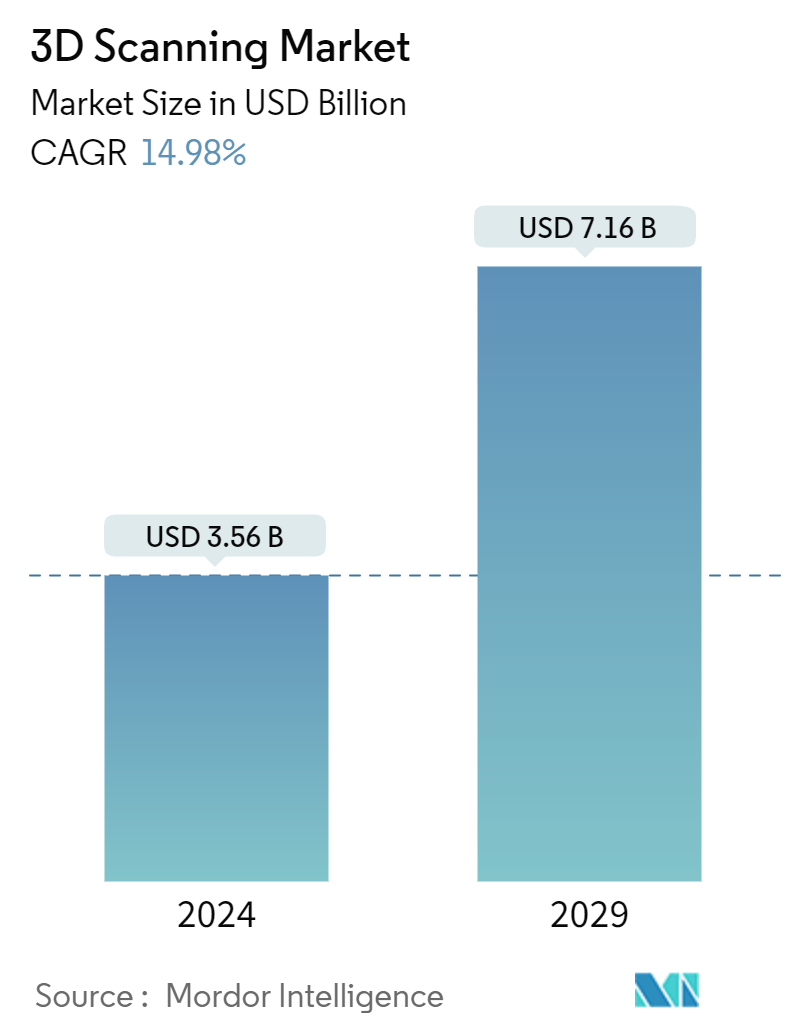
| Study Period | 2019 - 2029 |
| Market Size (2024) | USD 3.56 Billion |
| Market Size (2029) | USD 7.16 Billion |
| CAGR (2024 - 2029) | 14.98 % |
| Fastest Growing Market | Asia Pacific |
| Largest Market | North America |
Major Players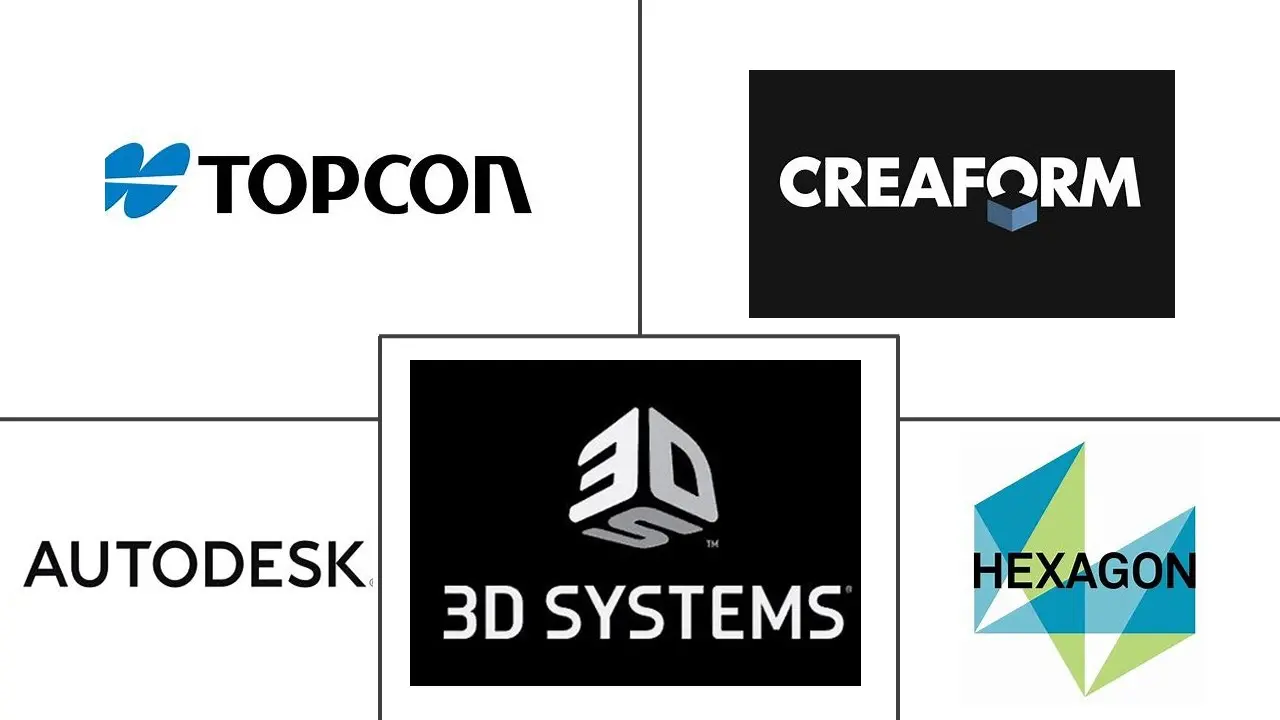
*Disclaimer: Major Players sorted in no particular order |
3D Scanning Market Analysis
The 3D Scanning Market size is estimated at USD 3.56 billion in 2024, and is expected to reach USD 7.16 billion by 2029, growing at a CAGR of 14.98% during the forecast period (2024-2029).
Though 3D scanning technology has not penetrated residential and private settings, these devices are prominently used to produce video games and movies in industries such as entertainment and media. Other industrial applications where these devices are found to be of great use are architecture, construction, aerospace, healthcare, and automotive, among others, where these can be used for onsite parts production. 3D scanners have been a part of the innovations led by applications.
- 3D scanning technology witnessed considerable adoption from commercial applications. Further, the flexibility of the technology to be customized to meet professional needs in various industries has made it profoundly popular across major end-user industries.
- Furthermore, 3D scanners are used in the construction industry to create a scaled 3D many-building structure. In the architectural industry, these devices help preserve and archive historical monuments from museums. Due to this technology's customizability and scalability, manufacturers rely on measurement accuracy and speed when building and developing advanced military and defense systems, using 3D scanners in making weapons and vehicles, such as frigates.
- Moreover, the growing construction or infrastructure activities across the globe will increase the demand for 3D scanning during the projected timeline. According to IBEF, the government has dramatically pushed the infrastructure sector by allocating USD 130.57 billion to enhance the infrastructure sector in India. Additionally, India plans to spend USD 1.4 trillion on infrastructure through the 'National Infrastructure Pipeline' in the following five years.
- In the medical sector, 3D scanners are used to model body parts in three dimensions, which are used to create prosthetics. It can also facilitate wound healing and care and generate body implants. 3D scanners are widely used by healthcare and medical professionals for creating custom-fit orthotic solutions, back braces, ergonomic prosthetic devices, dental implants, measurements, etc.
- Moreover, the increasing elderly population is expected to boost the demand for advanced technologies in the medical industry. According to the Burden of Digestive Diseases in the United States, it is estimated that more than 20 million GI endoscopies are performed yearly in the United States, whereas a total of 75 million endoscopies are performed in the U.S. every year. Also, as per the American Cancer Society, It is estimated that in 2023 there will be a total of 238,340 new cases of lung and bronchus cancer in the United States.
- Additionally, the rising adoption of 3D printing technology in various industries is one of the major factors thriving the adoption of 3D printers. As the adoption of 3D printers grows, the need for 3D scanning systems will increase simultaneously, driving market growth. 3D printers are experiencing this inflection point, likely because companies across multiple industries are increasingly using 3D printing technologies for more than just rapid prototyping.
- 3D scanning as a non-contact technique helped the thoracic chest scanning for COVID-19. The outbreak of this respiratory disease led to using 3D scanning technology as a useful tool to detect and quantify the COVID-19 virus.
3D Scanning Market Trends
Structured-light Scanner by Hardware Type to Drive the Market Growth
- A structured-light 3D scanner is a 3D scanning device for measuring the three-dimensional shape of an object using a single light source projecting multiple lines on the object being tracked by a camera or multiple cameras. This contrasts a laser scanner, which emits various laser dots on a single object, one after the other.
- Applications, such as reverse engineering of objects to produce CAD data, volume measurement of engineering parts, motion, and environment capture for augmented reality games, body measurements for fashion retailing, automated optical inspection in high-speed manufacturing lines, and obstacle detection systems on unmanned aircraft, have been actively deploying structured light scanners.
- By offering capabilities such as fast and no setup time, handheld 3D scanners conveniently integrate the same. Thus, multiple handheld 3D scanners for 3D printing have been deploying structured light technology. The technology uses trigonometric triangulation by projecting a light pattern onto the object to scan.
- The growing adoption of robots in the industrial sector will support the growth of the 3D scanning market. A structured light 3D scanner consists of a video projector and multiple cameras. The 3D scanner can be attached to a robotic arm, automatically moving around the object and 3D-scans it from all angles. These scanners can perform quick surface scans with the finest resolution in the range of a few microns and the highest accuracy.
- However, a significant downside of this type of scanner is sensitivity to the lighting conditions in a given environment, which poses a significant issue in working outside.
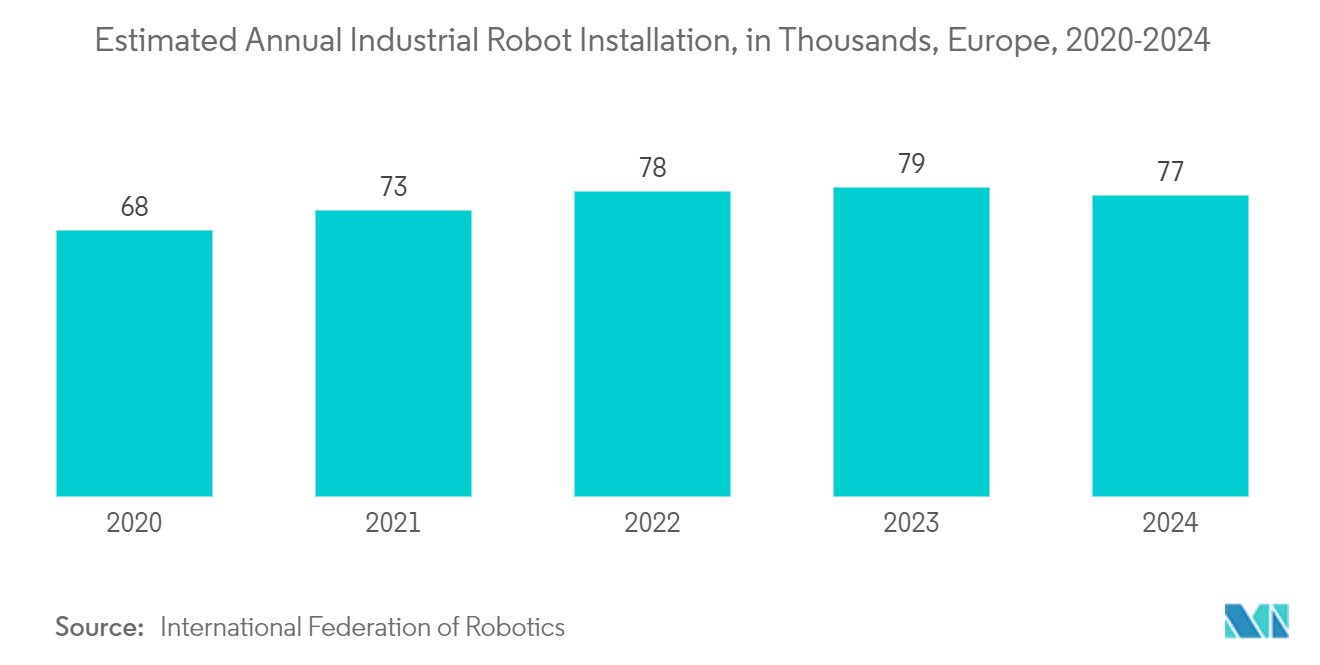
North America to Account for Major Share
- The United States is one of the most significant and consequential 3D scanning markets globally, with healthcare, aerospace and defense, architecture and engineering, 3D Digital Corporation, research and education, entertainment, and media as the significant, largest, and among some of the most advanced.
- 3D scanning opens up boundless possibilities for artists, allowing them to translate their most fantastic ideas into reality. For instance, the US media and entertainment (M&E) market, which is 33% of the global M&E industry, is the largest M&E market in the world, especially 3D animation production in the country, which houses the animation studios such as Disney and Pixar. The technology drives forward the movie industry and video games - many stunts and visual effects would have been difficult or even impossible to bring off before the advent of 3D scanning.
- Furthermore, the government invests in helping Canadian creative industries expand their global reach. For instance, in August 2022, the Federal government announced investing USD 11.2 million into 29 publishing, television, and video game companies, further supporting the market growth.
- Due to Canada's commitment to public access to healthcare, the government spending on healthcare exceeds 10% of Canada's GDP, one of the highest percentages in the developed world, equating to well over USD 5000 in healthcare spending per capita. These, coupled with the increased demand for plastic surgery, prosthetics, amputation, etc., provide new 3D scanners and scanning technologies.
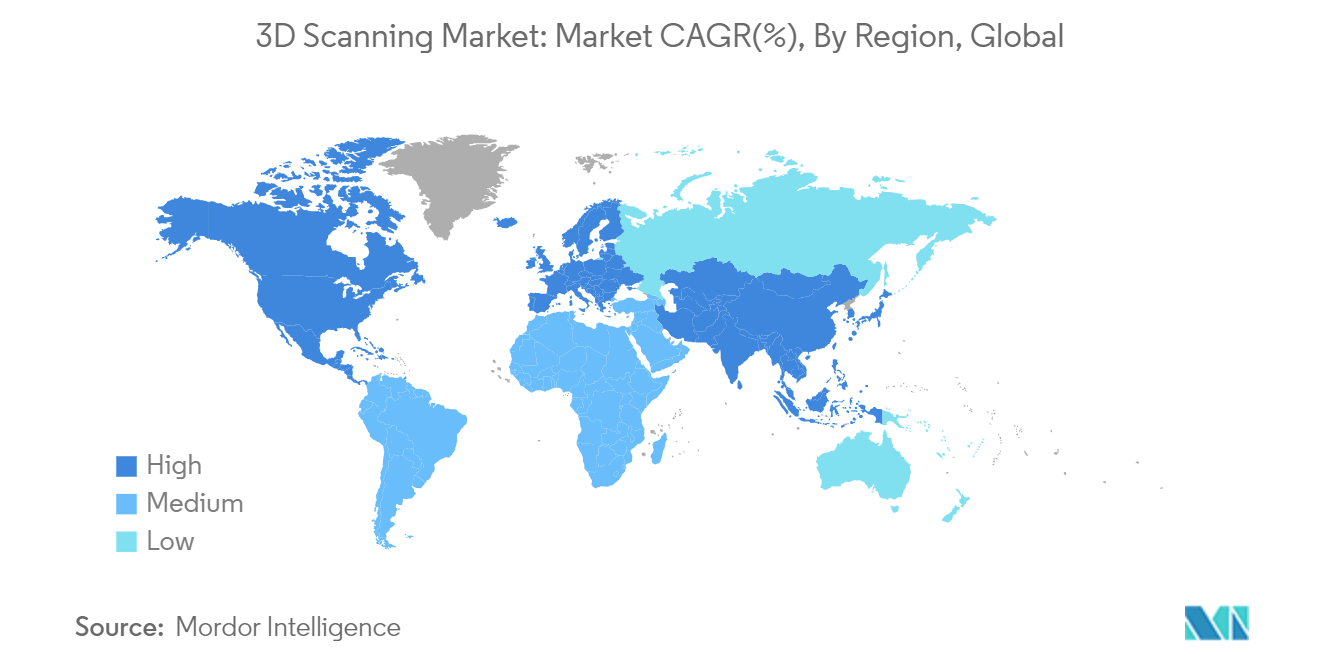
3D Scanning Industry Overview
The 3D scanning market is fragmented. Overall, the competitive rivalry among the existing competitors is high. Large and small companies new product innovation strategy is giving rise to the 3D scanning market. Some of the key developments in the area are:
- April 2023 - Shining 3D introduced its new multifunctional FreeScan Combo 3D scanner. FreeScanCombo adopts metrology-grade accuracy, fine scanning, and high precision from the FreeScan series while providing an even lighter and more compact design. It features 26 + 7 + 1 blue laser lines and an infrared scanning mode. These scanners are used for scanning scenarios such as reverse engineering, metrology-grade inspection, and further applications.
- March 2023 - Capture 3D introduced a ZEISS T-Scan Hawk 2. Developed and produced in Germany by ZEISS, this lightweight handheld 3D scanner includes a red laser marker for perfect distance control, new satellite mode, GOM Inspect 3D inspection software, and hyperscale calibration. The ZEISS T-SCAN Hawk 2 also comes with acceptance testing certified to the highest industry standards.
3D Scanning Market Leaders
-
3D Systems Inc.
-
Creaform
-
Topcon Corporation
-
Autodesk Inc.
-
Hexagon AB
*Disclaimer: Major Players sorted in no particular order
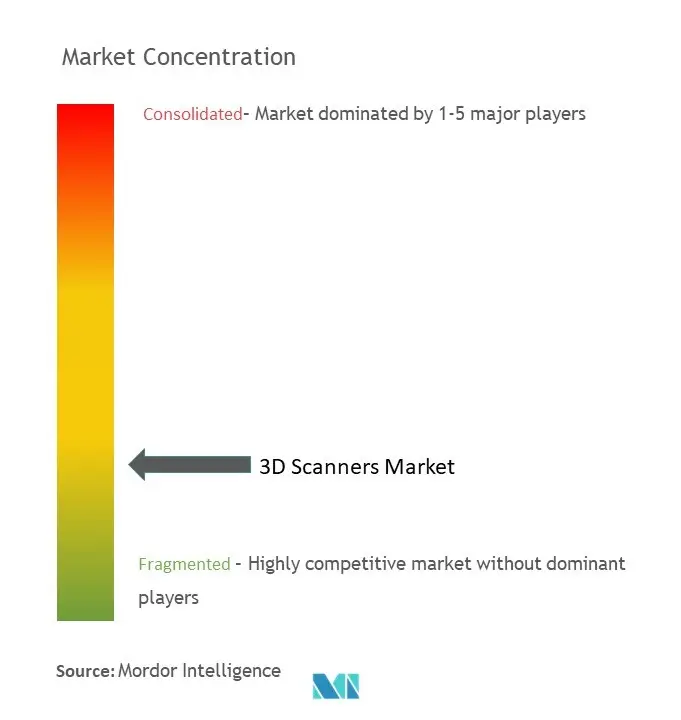
3D Scanning Market News
- February 2024 - Revopoint 3D released the MINI 2 3D scanner. It is the latest iteration of the MINI 3D scanners series. The updated Revopoint MINI 2 3D scanner provides professional-level ultra-detailed small object scanning capabilities at an affordable price for consumers and small businesses that need a time-saving tool for reverse engineering, quality control, design, and more applications.
- October 2023 - Creaform, an AMETEK, Inc. business unit, announced the latest addition to its flagship HandySCAN 3D line-up, the MAX Series. The handheld MAX Series is a line of industrial 3D scanners. It offers an impressive 3D scanning area of approximately 1m x 1m and was developed to acquire accurate 3D measurements of any large and complex surfaces.
3D Scanning Market Report - Table of Contents
1. INTRODUCTION
- 1.1 Study Assumptions and Market Definition
- 1.2 Scope of the Study
2. RESEARCH METHODOLOGY
3. EXECUTIVE SUMMARY
4. MARKET INSIGHTS
- 4.1 Market Overview
- 4.2 Industry Value Chain Analysis
-
4.3 Industry Attractiveness - Porter's Five Forces Analysis
- 4.3.1 Bargaining Power of Suppliers
- 4.3.2 Bargaining Power of Buyers
- 4.3.3 Threat of New Entrants
- 4.3.4 Threat of Substitute Products
- 4.3.5 Intensity of Competitive Rivalry
- 4.4 Assessment of the Impact of COVID-19 on the Market
5. MARKET DYNAMICS
-
5.1 Market Drivers
- 5.1.1 Significant Demand for 3D Metrology Across the Aerospace and Automobile Secto
- 5.1.2 Growth in Deployment of 3D Printers for Reconstructive Surgeries in the Healthcare Sector
-
5.2 Market Challenges
- 5.2.1 Significant Price of High-resolution 3D Scanners
6. MARKET SEGMENTATION
-
6.1 By Type
- 6.1.1 Hardware
- 6.1.1.1 Optical Scanners
- 6.1.1.2 Structured Light Scanners
- 6.1.1.3 Laser Scanners
- 6.1.1.4 Other Hardware
- 6.1.2 Software
-
6.2 By Range
- 6.2.1 Short Range
- 6.2.2 Medium Range
- 6.2.3 Long Range
-
6.3 By Application
- 6.3.1 Reverse Engineering
- 6.3.2 Rapid Prototyping
- 6.3.3 Quality Control/Inspection
- 6.3.4 Face and Body Scanning
- 6.3.5 Industrial Metrology
- 6.3.6 Digital Modeling
-
6.4 By End-user Vertical
- 6.4.1 Aerospace and Defense
- 6.4.2 Automotive
- 6.4.3 Healthcare
- 6.4.4 Manufacturing
- 6.4.5 Media and Entertainment
- 6.4.6 Architecture and Construction
- 6.4.7 Other End-user Verticals
-
6.5 By Geography
- 6.5.1 North America
- 6.5.2 Europe
- 6.5.3 Asia Pacific
- 6.5.4 Latin America
- 6.5.5 Middle East and Africa
7. COMPETITIVE LANDSCAPE
-
7.1 Company Profiles
- 7.1.1 3D Systems Inc.
- 7.1.2 CREAFORM Inc.
- 7.1.3 GOM GmbH
- 7.1.4 Faro Technologies Inc.
- 7.1.5 Topcon Corporation
- 7.1.6 Maptek Pty Ltd
- 7.1.7 Autodesk Inc.
- 7.1.8 Artec Inc.
- 7.1.9 Hexagon AB
- 7.1.10 Trimble Inc.
- *List Not Exhaustive
8. INVESTMENT ANALYSIS
9. FUTURE OF THE MARKET
** Subject To Availablity3D Scanning Industry Segmentation
3D scanners capture the details of a real-world object, including dimensions, texture, and color, which can then be used to reproduce 3D models. As part of the study's scope, 3D scanning equipment and software have been considered. Optical scanners, structured light scanners, and laser scanners have been considered within the hardware.
The 3D scanning market is segmented by Type (Hardware, Software), Range (Short, Medium, Long), Application (Reverse Engineering, Rapid Prototyping, Quality Control/Inspection, Industrial Metrology, Face and Body Scanning, Digital Modeling), End-user Vertical (Aerospace and Defense, Automotive, Healthcare, Manufacturing, Media and Entertainment, Architecture and Construction), and Geography (North America, Europe, Asia Pacific, Latin America, and Middle East and Africa). The report offers the market size in value terms in USD for all the above mentioned segments.
| By Type | Hardware | Optical Scanners |
| Structured Light Scanners | ||
| Laser Scanners | ||
| Other Hardware | ||
| By Type | Software | |
| By Range | Short Range | |
| Medium Range | ||
| Long Range | ||
| By Application | Reverse Engineering | |
| Rapid Prototyping | ||
| Quality Control/Inspection | ||
| Face and Body Scanning | ||
| Industrial Metrology | ||
| Digital Modeling | ||
| By End-user Vertical | Aerospace and Defense | |
| Automotive | ||
| Healthcare | ||
| Manufacturing | ||
| Media and Entertainment | ||
| Architecture and Construction | ||
| Other End-user Verticals | ||
| By Geography | North America | |
| Europe | ||
| Asia Pacific | ||
| Latin America | ||
| Middle East and Africa |
3D Scanning Market Research FAQs
How big is the 3D Scanning Market?
The 3D Scanning Market size is expected to reach USD 3.56 billion in 2024 and grow at a CAGR of 14.98% to reach USD 7.16 billion by 2029.
What is the current 3D Scanning Market size?
In 2024, the 3D Scanning Market size is expected to reach USD 3.56 billion.
Who are the key players in 3D Scanning Market?
3D Systems Inc., Creaform, Topcon Corporation, Autodesk Inc. and Hexagon AB are the major companies operating in the 3D Scanning Market.
Which is the fastest growing region in 3D Scanning Market?
Asia Pacific is estimated to grow at the highest CAGR over the forecast period (2024-2029).
Which region has the biggest share in 3D Scanning Market?
In 2024, the North America accounts for the largest market share in 3D Scanning Market.
What years does this 3D Scanning Market cover, and what was the market size in 2023?
In 2023, the 3D Scanning Market size was estimated at USD 3.03 billion. The report covers the 3D Scanning Market historical market size for years: 2019, 2020, 2021, 2022 and 2023. The report also forecasts the 3D Scanning Market size for years: 2024, 2025, 2026, 2027, 2028 and 2029.
What are the key industries driving the demand for 3D Scanners Market?
Key industries including manufacturing, healthcare, aerospace, and automotive are driving the demand for 3D Scanners Industry. These sectors utilize 3D scanning for quality control, prototyping, and reverse engineering.
3D Scanner Technology Industry Report
The global 3D scanning industry is witnessing remarkable growth, fueled by its increasing demand across diverse sectors such as automotive, healthcare, architecture, and construction. This surge is attributed to the technology's versatility and its critical role in enhancing design, quality control, and inspection processes in the automotive sector, revolutionizing prosthetic design and wound healing in healthcare, and increasing precision in architecture and construction. Additionally, its application in public safety for crime scene and accident reconstruction presents new opportunities.
The market size of the 3D scanning industry is comprehensively analyzed in Mordor Intelligence™ Industry Reports. These market reports offer a detailed market analysis, including market share, market forecast, and market growth. The industry overview provides insights into the market value and market segmentation, covering various applications and end-user verticals.
The industry analysis highlights the industry trends and industry outlook, emphasizing the industry's potential and strategic market analysis. The market data and industry statistics are presented in a report pdf, which includes industry information, industry research, and industry sales.
The market review and market predictions underscore the industry's growth rate and the role of market leaders in driving the market's expansion. The market research covers the industry size and market overview, providing a comprehensive understanding of the industry's dynamics.
For detailed insights, download a free report pdf sample, showcasing the industry's potential and strategic market analysis. This report example serves as a valuable resource for research companies and stakeholders interested in the 3D scanning market. The industry reports and industry outlook provide a thorough understanding of the market trends and market outlook, ensuring informed decision-making for businesses and investors.



